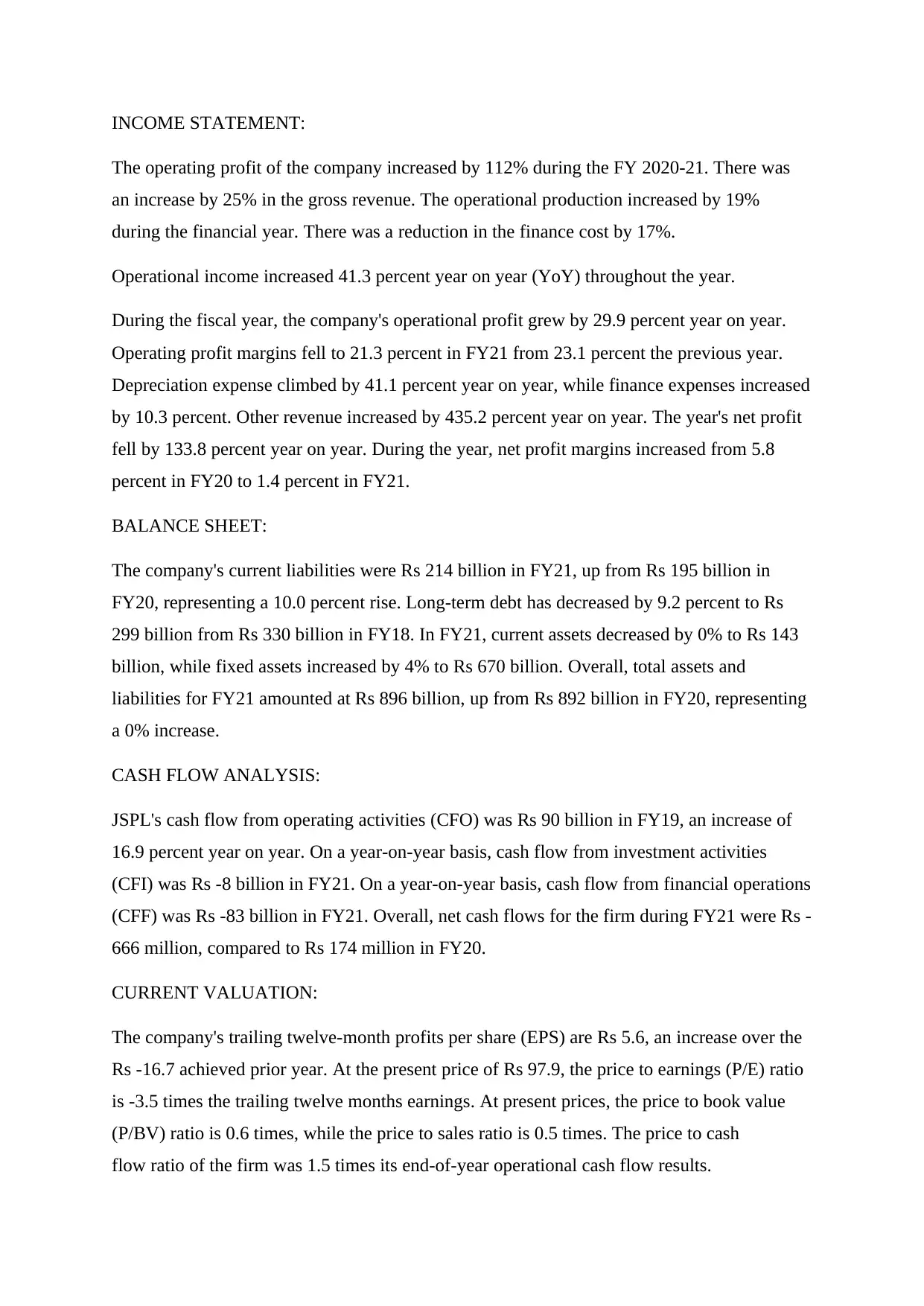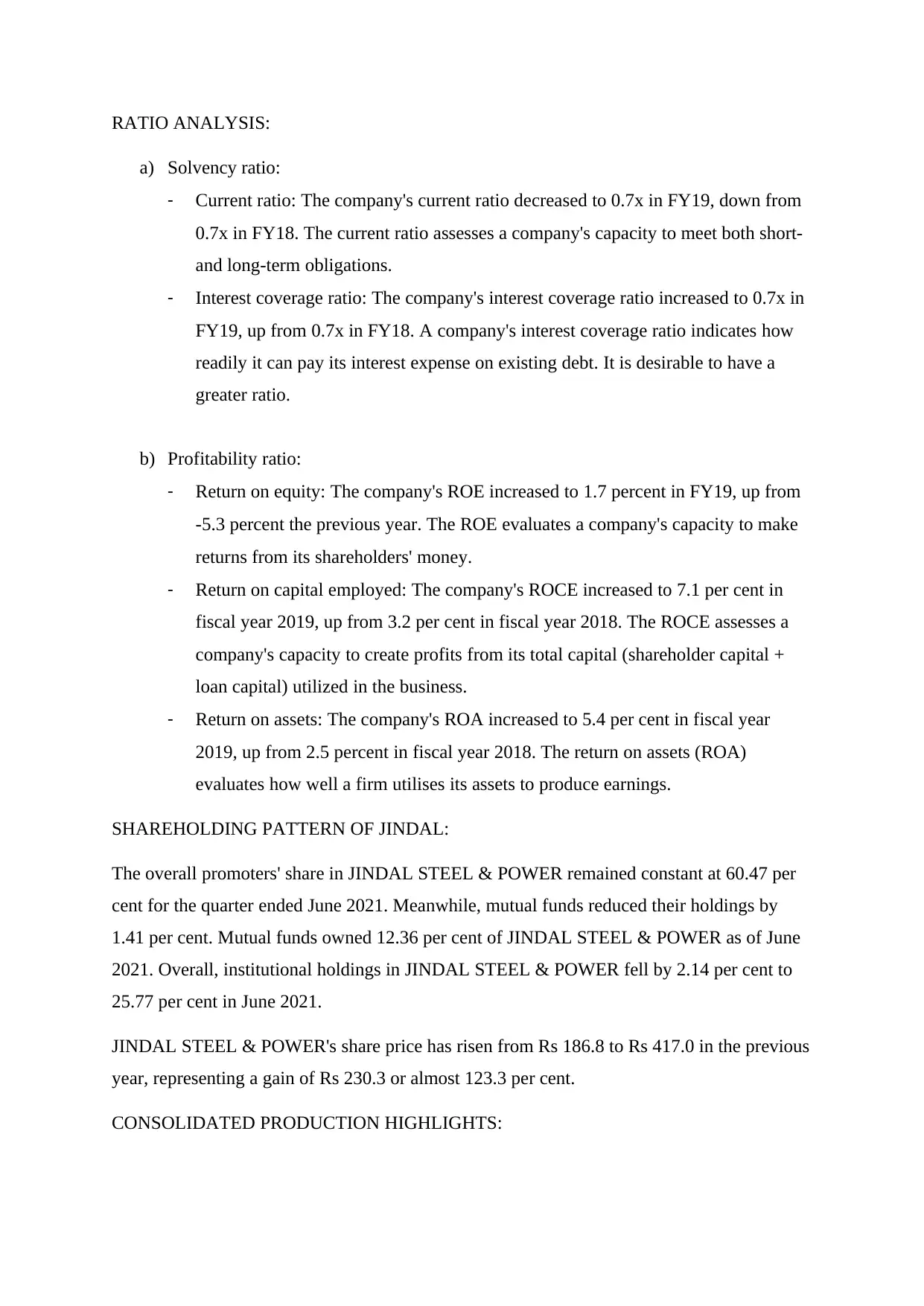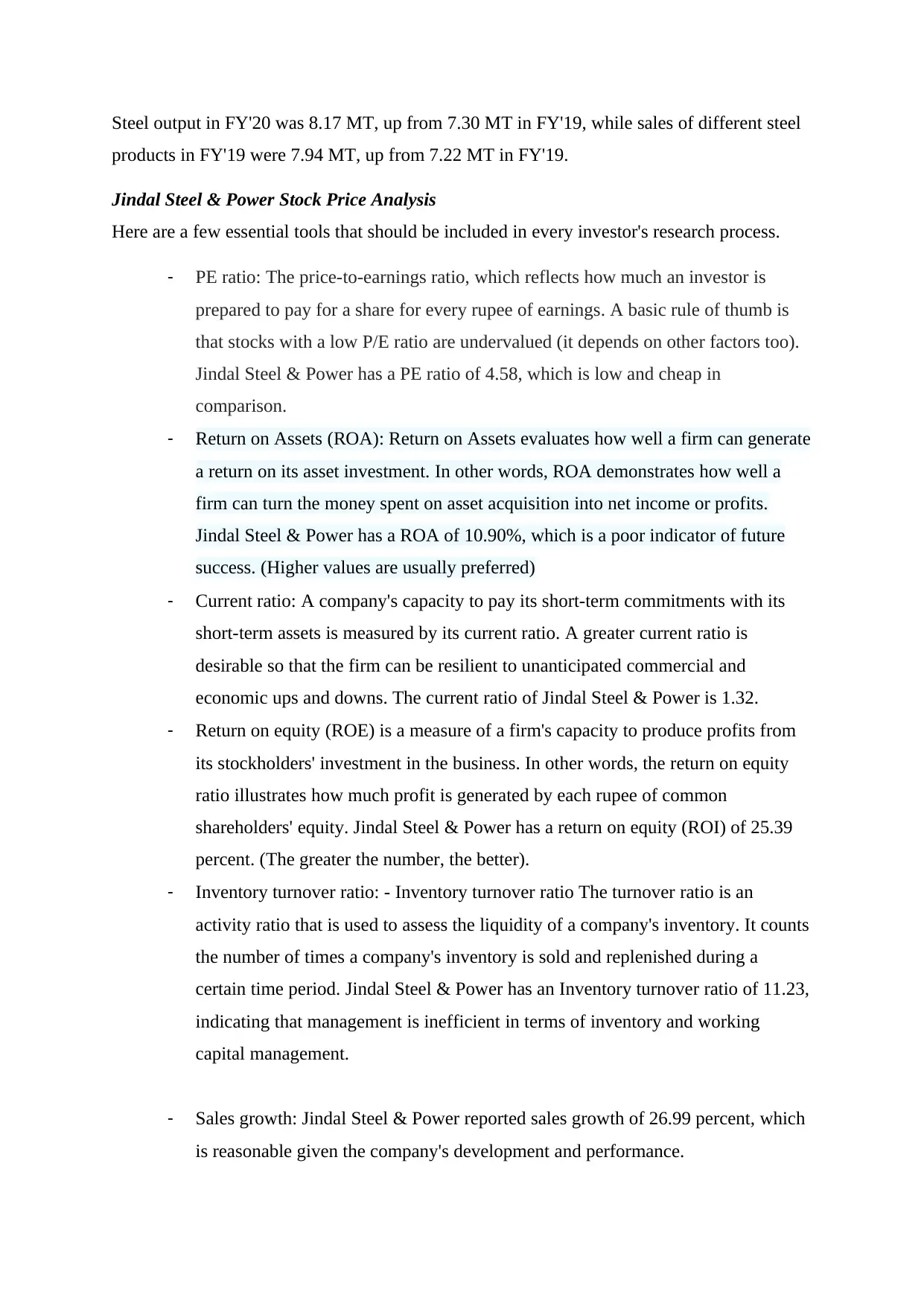In-Depth Financial Performance Review: Jindal Steel & Power
VerifiedAdded on 2022/01/27
|4
|1237
|22
Report
AI Summary
This report provides a detailed financial analysis of Jindal Steel & Power (JSPL), examining its performance across various financial metrics. The analysis covers the income statement, highlighting changes in operating profit, gross revenue, and net profit margins. The balance sheet reveals trends in current liabilities, long-term debt, and asset composition. Cash flow analysis assesses the company's operating, investment, and financing activities, with a focus on net cash flows. Current valuation metrics such as P/E ratio, P/BV ratio, and P/S ratio are presented, along with a review of key ratios like the current ratio, interest coverage ratio, return on equity (ROE), return on capital employed (ROCE), and return on assets (ROA). Additionally, the report includes an overview of Jindal's shareholding pattern and production highlights, along with essential tools for investors like PE ratio, ROA, current ratio, ROE, inventory turnover ratio, and sales growth. This report provides a comprehensive view of JSPL's financial health and performance.

INCOME STATEMENT:
The operating profit of the company increased by 112% during the FY 2020-21. There was
an increase by 25% in the gross revenue. The operational production increased by 19%
during the financial year. There was a reduction in the finance cost by 17%.
Operational income increased 41.3 percent year on year (YoY) throughout the year.
During the fiscal year, the company's operational profit grew by 29.9 percent year on year.
Operating profit margins fell to 21.3 percent in FY21 from 23.1 percent the previous year.
Depreciation expense climbed by 41.1 percent year on year, while finance expenses increased
by 10.3 percent. Other revenue increased by 435.2 percent year on year. The year's net profit
fell by 133.8 percent year on year. During the year, net profit margins increased from 5.8
percent in FY20 to 1.4 percent in FY21.
BALANCE SHEET:
The company's current liabilities were Rs 214 billion in FY21, up from Rs 195 billion in
FY20, representing a 10.0 percent rise. Long-term debt has decreased by 9.2 percent to Rs
299 billion from Rs 330 billion in FY18. In FY21, current assets decreased by 0% to Rs 143
billion, while fixed assets increased by 4% to Rs 670 billion. Overall, total assets and
liabilities for FY21 amounted at Rs 896 billion, up from Rs 892 billion in FY20, representing
a 0% increase.
CASH FLOW ANALYSIS:
JSPL's cash flow from operating activities (CFO) was Rs 90 billion in FY19, an increase of
16.9 percent year on year. On a year-on-year basis, cash flow from investment activities
(CFI) was Rs -8 billion in FY21. On a year-on-year basis, cash flow from financial operations
(CFF) was Rs -83 billion in FY21. Overall, net cash flows for the firm during FY21 were Rs -
666 million, compared to Rs 174 million in FY20.
CURRENT VALUATION:
The company's trailing twelve-month profits per share (EPS) are Rs 5.6, an increase over the
Rs -16.7 achieved prior year. At the present price of Rs 97.9, the price to earnings (P/E) ratio
is -3.5 times the trailing twelve months earnings. At present prices, the price to book value
(P/BV) ratio is 0.6 times, while the price to sales ratio is 0.5 times. The price to cash
flow ratio of the firm was 1.5 times its end-of-year operational cash flow results.
The operating profit of the company increased by 112% during the FY 2020-21. There was
an increase by 25% in the gross revenue. The operational production increased by 19%
during the financial year. There was a reduction in the finance cost by 17%.
Operational income increased 41.3 percent year on year (YoY) throughout the year.
During the fiscal year, the company's operational profit grew by 29.9 percent year on year.
Operating profit margins fell to 21.3 percent in FY21 from 23.1 percent the previous year.
Depreciation expense climbed by 41.1 percent year on year, while finance expenses increased
by 10.3 percent. Other revenue increased by 435.2 percent year on year. The year's net profit
fell by 133.8 percent year on year. During the year, net profit margins increased from 5.8
percent in FY20 to 1.4 percent in FY21.
BALANCE SHEET:
The company's current liabilities were Rs 214 billion in FY21, up from Rs 195 billion in
FY20, representing a 10.0 percent rise. Long-term debt has decreased by 9.2 percent to Rs
299 billion from Rs 330 billion in FY18. In FY21, current assets decreased by 0% to Rs 143
billion, while fixed assets increased by 4% to Rs 670 billion. Overall, total assets and
liabilities for FY21 amounted at Rs 896 billion, up from Rs 892 billion in FY20, representing
a 0% increase.
CASH FLOW ANALYSIS:
JSPL's cash flow from operating activities (CFO) was Rs 90 billion in FY19, an increase of
16.9 percent year on year. On a year-on-year basis, cash flow from investment activities
(CFI) was Rs -8 billion in FY21. On a year-on-year basis, cash flow from financial operations
(CFF) was Rs -83 billion in FY21. Overall, net cash flows for the firm during FY21 were Rs -
666 million, compared to Rs 174 million in FY20.
CURRENT VALUATION:
The company's trailing twelve-month profits per share (EPS) are Rs 5.6, an increase over the
Rs -16.7 achieved prior year. At the present price of Rs 97.9, the price to earnings (P/E) ratio
is -3.5 times the trailing twelve months earnings. At present prices, the price to book value
(P/BV) ratio is 0.6 times, while the price to sales ratio is 0.5 times. The price to cash
flow ratio of the firm was 1.5 times its end-of-year operational cash flow results.
Paraphrase This Document
Need a fresh take? Get an instant paraphrase of this document with our AI Paraphraser

RATIO ANALYSIS:
a) Solvency ratio:
- Current ratio: The company's current ratio decreased to 0.7x in FY19, down from
0.7x in FY18. The current ratio assesses a company's capacity to meet both short-
and long-term obligations.
- Interest coverage ratio: The company's interest coverage ratio increased to 0.7x in
FY19, up from 0.7x in FY18. A company's interest coverage ratio indicates how
readily it can pay its interest expense on existing debt. It is desirable to have a
greater ratio.
b) Profitability ratio:
- Return on equity: The company's ROE increased to 1.7 percent in FY19, up from
-5.3 percent the previous year. The ROE evaluates a company's capacity to make
returns from its shareholders' money.
- Return on capital employed: The company's ROCE increased to 7.1 per cent in
fiscal year 2019, up from 3.2 per cent in fiscal year 2018. The ROCE assesses a
company's capacity to create profits from its total capital (shareholder capital +
loan capital) utilized in the business.
- Return on assets: The company's ROA increased to 5.4 per cent in fiscal year
2019, up from 2.5 percent in fiscal year 2018. The return on assets (ROA)
evaluates how well a firm utilises its assets to produce earnings.
SHAREHOLDING PATTERN OF JINDAL:
The overall promoters' share in JINDAL STEEL & POWER remained constant at 60.47 per
cent for the quarter ended June 2021. Meanwhile, mutual funds reduced their holdings by
1.41 per cent. Mutual funds owned 12.36 per cent of JINDAL STEEL & POWER as of June
2021. Overall, institutional holdings in JINDAL STEEL & POWER fell by 2.14 per cent to
25.77 per cent in June 2021.
JINDAL STEEL & POWER's share price has risen from Rs 186.8 to Rs 417.0 in the previous
year, representing a gain of Rs 230.3 or almost 123.3 per cent.
CONSOLIDATED PRODUCTION HIGHLIGHTS:
a) Solvency ratio:
- Current ratio: The company's current ratio decreased to 0.7x in FY19, down from
0.7x in FY18. The current ratio assesses a company's capacity to meet both short-
and long-term obligations.
- Interest coverage ratio: The company's interest coverage ratio increased to 0.7x in
FY19, up from 0.7x in FY18. A company's interest coverage ratio indicates how
readily it can pay its interest expense on existing debt. It is desirable to have a
greater ratio.
b) Profitability ratio:
- Return on equity: The company's ROE increased to 1.7 percent in FY19, up from
-5.3 percent the previous year. The ROE evaluates a company's capacity to make
returns from its shareholders' money.
- Return on capital employed: The company's ROCE increased to 7.1 per cent in
fiscal year 2019, up from 3.2 per cent in fiscal year 2018. The ROCE assesses a
company's capacity to create profits from its total capital (shareholder capital +
loan capital) utilized in the business.
- Return on assets: The company's ROA increased to 5.4 per cent in fiscal year
2019, up from 2.5 percent in fiscal year 2018. The return on assets (ROA)
evaluates how well a firm utilises its assets to produce earnings.
SHAREHOLDING PATTERN OF JINDAL:
The overall promoters' share in JINDAL STEEL & POWER remained constant at 60.47 per
cent for the quarter ended June 2021. Meanwhile, mutual funds reduced their holdings by
1.41 per cent. Mutual funds owned 12.36 per cent of JINDAL STEEL & POWER as of June
2021. Overall, institutional holdings in JINDAL STEEL & POWER fell by 2.14 per cent to
25.77 per cent in June 2021.
JINDAL STEEL & POWER's share price has risen from Rs 186.8 to Rs 417.0 in the previous
year, representing a gain of Rs 230.3 or almost 123.3 per cent.
CONSOLIDATED PRODUCTION HIGHLIGHTS:

Steel output in FY'20 was 8.17 MT, up from 7.30 MT in FY'19, while sales of different steel
products in FY'19 were 7.94 MT, up from 7.22 MT in FY'19.
Jindal Steel & Power Stock Price Analysis
Here are a few essential tools that should be included in every investor's research process.
- PE ratio: The price-to-earnings ratio, which reflects how much an investor is
prepared to pay for a share for every rupee of earnings. A basic rule of thumb is
that stocks with a low P/E ratio are undervalued (it depends on other factors too).
Jindal Steel & Power has a PE ratio of 4.58, which is low and cheap in
comparison.
- Return on Assets (ROA): Return on Assets evaluates how well a firm can generate
a return on its asset investment. In other words, ROA demonstrates how well a
firm can turn the money spent on asset acquisition into net income or profits.
Jindal Steel & Power has a ROA of 10.90%, which is a poor indicator of future
success. (Higher values are usually preferred)
- Current ratio: A company's capacity to pay its short-term commitments with its
short-term assets is measured by its current ratio. A greater current ratio is
desirable so that the firm can be resilient to unanticipated commercial and
economic ups and downs. The current ratio of Jindal Steel & Power is 1.32.
- Return on equity (ROE) is a measure of a firm's capacity to produce profits from
its stockholders' investment in the business. In other words, the return on equity
ratio illustrates how much profit is generated by each rupee of common
shareholders' equity. Jindal Steel & Power has a return on equity (ROI) of 25.39
percent. (The greater the number, the better).
- Inventory turnover ratio: - Inventory turnover ratio The turnover ratio is an
activity ratio that is used to assess the liquidity of a company's inventory. It counts
the number of times a company's inventory is sold and replenished during a
certain time period. Jindal Steel & Power has an Inventory turnover ratio of 11.23,
indicating that management is inefficient in terms of inventory and working
capital management.
- Sales growth: Jindal Steel & Power reported sales growth of 26.99 percent, which
is reasonable given the company's development and performance.
products in FY'19 were 7.94 MT, up from 7.22 MT in FY'19.
Jindal Steel & Power Stock Price Analysis
Here are a few essential tools that should be included in every investor's research process.
- PE ratio: The price-to-earnings ratio, which reflects how much an investor is
prepared to pay for a share for every rupee of earnings. A basic rule of thumb is
that stocks with a low P/E ratio are undervalued (it depends on other factors too).
Jindal Steel & Power has a PE ratio of 4.58, which is low and cheap in
comparison.
- Return on Assets (ROA): Return on Assets evaluates how well a firm can generate
a return on its asset investment. In other words, ROA demonstrates how well a
firm can turn the money spent on asset acquisition into net income or profits.
Jindal Steel & Power has a ROA of 10.90%, which is a poor indicator of future
success. (Higher values are usually preferred)
- Current ratio: A company's capacity to pay its short-term commitments with its
short-term assets is measured by its current ratio. A greater current ratio is
desirable so that the firm can be resilient to unanticipated commercial and
economic ups and downs. The current ratio of Jindal Steel & Power is 1.32.
- Return on equity (ROE) is a measure of a firm's capacity to produce profits from
its stockholders' investment in the business. In other words, the return on equity
ratio illustrates how much profit is generated by each rupee of common
shareholders' equity. Jindal Steel & Power has a return on equity (ROI) of 25.39
percent. (The greater the number, the better).
- Inventory turnover ratio: - Inventory turnover ratio The turnover ratio is an
activity ratio that is used to assess the liquidity of a company's inventory. It counts
the number of times a company's inventory is sold and replenished during a
certain time period. Jindal Steel & Power has an Inventory turnover ratio of 11.23,
indicating that management is inefficient in terms of inventory and working
capital management.
- Sales growth: Jindal Steel & Power reported sales growth of 26.99 percent, which
is reasonable given the company's development and performance.
⊘ This is a preview!⊘
Do you want full access?
Subscribe today to unlock all pages.

Trusted by 1+ million students worldwide

1 out of 4
Related Documents
Your All-in-One AI-Powered Toolkit for Academic Success.
+13062052269
info@desklib.com
Available 24*7 on WhatsApp / Email
![[object Object]](/_next/static/media/star-bottom.7253800d.svg)
Unlock your academic potential
Copyright © 2020–2025 A2Z Services. All Rights Reserved. Developed and managed by ZUCOL.





